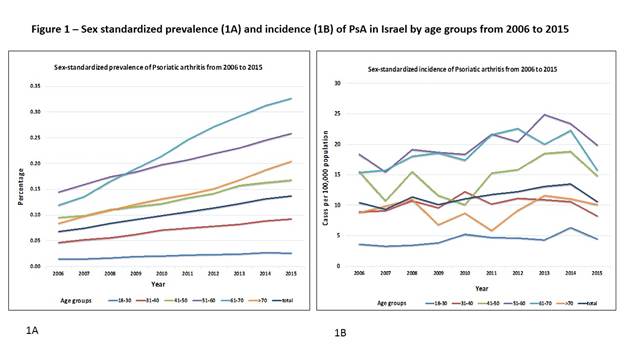Session Information
Date: Monday, November 6, 2017
Title: Epidemiology and Public Health Poster II: Rheumatic Diseases Other than Rheumatoid Arthritis
Session Type: ACR Poster Session B
Session Time: 9:00AM-11:00AM
Background/Purpose: There is limited information on the epidemiology of Psoriatic Arthritis (PsA) in general and in Middle Eastern populations in particular. The aims of this study were to estimate the prevalence and incidence rates of PsA and their temporal trends in the general population in Israel.
Methods: In this study, we derived a cohort of adult patients with PsA from the database of Clalit Health Services (CHS), Israel’s largest health fund, with over 4.4 million members (52% of Israel’s population). PsA cases were identified if they fulfilled one of the following conditions: 1) PsA diagnosis assigned at least once by a rheumatologist; 2) permanent diagnosis code assigned by a family physician combined with use of synthetic or biologic disease modifying antirheumatic drugs; 3) PsA code listed in a hospitalization discharge summary. This algorithm had positive predictive value, sensitivity and specificity of 90.5%, 88.7% and 88.1%, respectively.
We calculated crude and age- and sex-standardized prevalence and incidence rates of PsA from 2006 to 2015 in the general population. The variation in PsA prevalence was assessed in relation to several demographic factors.
Results: Among the 2,931,199 individuals aged 18 years and older registered in the CHS database in 2015, 4490 patients had a diagnosis of PsA (322 incident cases), resulting in overall crude prevalence and incidence rates of 0.153% (95% CI 0.149%, 0.158%) and 10.9 (95% CI% 9.8, 12.3) per 100,000 population, respectively. The prevalence of PsA in Israel doubled between 2006 and 2015 (0.073% to 0.153%). In contrast, the global incidence rate remained stable, with a gradual increase in the incidence among individuals aged 51 to 70 years (Figure 1). PsA is associated with Jewish ethnicity, high socioeconomic status, rural residency and higher body mass index (Table 1).
Conclusion: The prevalence and incidence of PsA in Israel are within the range of previous estimates from Southern European populations. An increase in the prevalence of PsA was observed over the past decade in the general population in Israel.
|
Table 1 – Prevalence of PsA by demographic characteristics |
|||
|
|
Prevalence (%) |
OR |
95% CI |
|
Sex |
|
|
|
|
Male |
0.147 |
0.93 |
0.87, 0.98 |
|
Female |
0.159 |
|
|
|
Socioeconomic status |
|
|
|
|
High |
0.204 |
1.76 |
1.63, 1.90 |
|
Middle |
0.167 |
1.44 |
1.35, 1.55 |
|
Low |
0.116 |
|
|
|
Ethnicity |
|
|
|
|
Jewish |
0.175 |
2.13 |
1.95, 2.33 |
|
Arab |
0.082 |
|
|
|
Residential Area |
|
|
|
|
Urban |
0.151 |
0.82 |
0.73, 0.92 |
|
Rural |
0.184 |
|
|
|
BMI |
|
|
|
|
>30 |
0.266 |
2.57 |
2.37, 2.80 |
|
25-30 |
0.200 |
1.94 |
1.78, 2.10 |
To cite this abstract in AMA style:
Eder L, Cohen AD, Feldhamer I, Greenberg-Dotan S, Batat E, Zisman D. The Epidemiology of Psoriatic Arthritis in Israel – a Population-Based Study [abstract]. Arthritis Rheumatol. 2017; 69 (suppl 10). https://acrabstracts.org/abstract/the-epidemiology-of-psoriatic-arthritis-in-israel-a-population-based-study/. Accessed .« Back to 2017 ACR/ARHP Annual Meeting
ACR Meeting Abstracts - https://acrabstracts.org/abstract/the-epidemiology-of-psoriatic-arthritis-in-israel-a-population-based-study/

